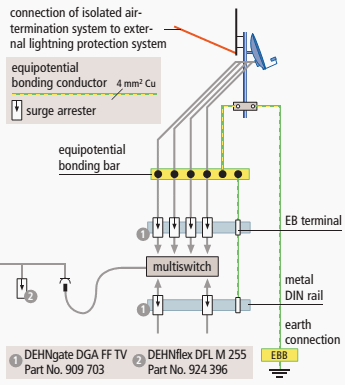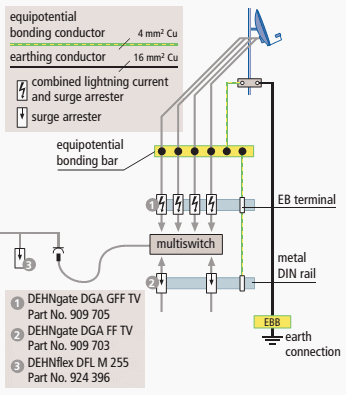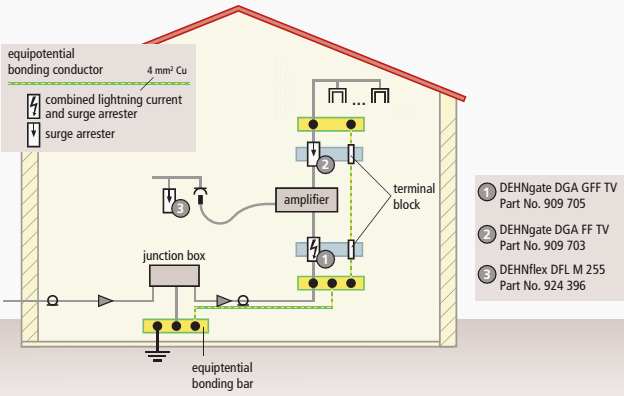
Lightning And Surge Protection For Cable Networks And Antennas For TV PART 2 - (photo by dipolnet.com)
Continued from part one:
Lightning And Surge Protection For Cable Networks And Antennas For TV (Part 1)
Protective Mechanisms
If an antenna is protected by isolated air-termination systems it means:
- That in the area of flat roofs an air-termination rod will be installed with the required separation distance s, putting the whole antenna arrangement (mast and antennas) in the protective zone of the protective angle (Figure 4).
Now the antenna arrangement is no longer in lightning protection zone LPZ 0A (risk of direct lightning currents) but lightning protection zone LPZ 0B (risk of indirect impulse currents and of the unattenuated electromagnetic field of lightning).

Figure 4 - Antenna with air-termination rod on a flat roof of buildings with external lightning protection system
- That in the area of pitched roofs an air-termination rod will be installed with the required separation distance s using highly insulating distance holders (DEHNiso distance holders) to fix it at the antenna mast, putting the whole antenna arrangement (mast and antenna) into the protective zone of the protective angle (according to the applicable class of LPS) - Figure 5.

Figure 5 - Antenna with air-termination rod and highly insulating distance holder on pitched roofs with external lightning protection system
Also here the antenna arrangement is no longer in lightning protection zone LPZ 0A (risk of direct lightning currents), but in lightning protection zone LPZ 0B (risk of indirect impulse currents and of the unattenuated electromagnetic field of lightning).

Figure 6 - Surge protective devices downstream the equipotential bonding bar for the coaxial cable shields in case of antenna systems with external lightning protection system and isolated air-termination system
These surge protective devices to be used both as single devices and for rail mounting protect the downstream devices against inductive and/or capacitive inputs of waveform 8/20 μs, arising from cloud/cloud flashes, distant strikes or direct strikes into the isolated air-termination system.
Surge protective devices Type 3 have to be provided for any electrical equipment with 230/50 Hz downstream the equipotential bonding bar, which is installed for the coaxial cable shields. Care has to be taken that the lightning equipotential bonding is carried out for all systems leading into the building.
A lightning protection system not being installed, the following is recommended:

Figure 7 - Surge protective devices downstream the equipotential bonding bar for the coaxial cable shields in case of antenna systems without external lightning protection system and with isolated air-termination system
- An air-termination rod mounted with insulated distance holders prevents from a direct strike to the antenna. For this the air-termination rod has to be connected with the earth electrode by a separately installed earthing conductor (Figure 7) to be guided preferably on the outside of the building and to be connected with the earth electrode at ground level.

Figure 8 - Combined lightning current and surge arresters downstream the equipotential bonding bar for the coaxial cable shields in case of antenna systems without external lightning protection system
- If the antenna mast is earthed directly, combined lightning current and surge arresters have to be provided (Figure 8), because partial lightning currents, which the surge arresters are not able to control, will be conducted in this case through the coaxial cables.
The antenna mast has to be connected with the earth electrode by an earthing conductor.

Figure 9 - mbined lightning current and surge arresters downstream the equipotential bonding bar for the coaxial cable shields in case of underground cable networks
Underground utility lines of systems require combined lightning current and surge arresters being able to carry lightning currents. They also have to be mounted near the point of entrance into the building (Figure 9).
Reference: Lightning Protection Guide – DEHN Inc. (dehn.de)